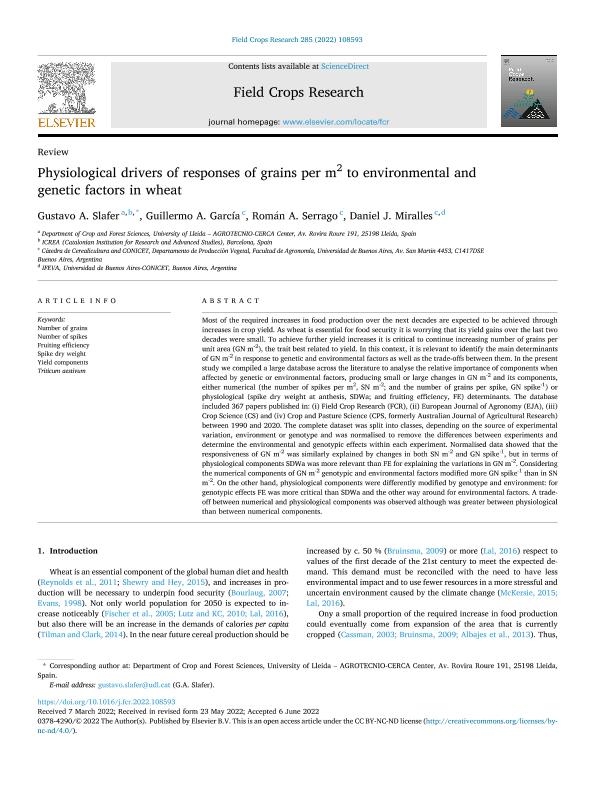Mostrar el registro sencillo del ítem
dc.contributor.author
Slafer, Gustavo Ariel

dc.contributor.author
García, Guillermo Ariel

dc.contributor.author
Serrago, Roman Augusto

dc.contributor.author
Miralles, Daniel Julio

dc.date.available
2023-09-06T14:16:45Z
dc.date.issued
2022-09
dc.identifier.citation
Slafer, Gustavo Ariel; García, Guillermo Ariel; Serrago, Roman Augusto; Miralles, Daniel Julio; Physiological drivers of responses of grains per m2 to environmental and genetic factors in wheat; Elsevier Science; Field Crops Research; 285; 9-2022; 1-24
dc.identifier.issn
0378-4290
dc.identifier.uri
http://hdl.handle.net/11336/210678
dc.description.abstract
Most of the required increases in food production over the next decades are expected to be achieved through increases in crop yield. As wheat is essential for food security it is worrying that its yield gains over the last two decades were small. To achieve further yield increases it is critical to continue increasing number of grains per unit area (GN m-2), the trait best related to yield. In this context, it is relevant to identify the main determinants of GN m-2 in response to genetic and environmental factors as well as the trade-offs between them. In the present study we compiled a large database across the literature to analyse the relative importance of components when affected by genetic or environmental factors, producing small or large changes in GN m-2 and its components, either numerical (the number of spikes per m2, SN m-2; and the number of grains per spike, GN spike-1) or physiological (spike dry weight at anthesis, SDWa; and fruiting efficiency, FE) determinants. The database included 367 papers published in: (i) Field Crop Research (FCR), (ii) European Journal of Agronomy (EJA), (iii) Crop Science (CS) and (iv) Crop and Pasture Science (CPS, formerly Australian Journal of Agricultural Research) between 1990 and 2020. The complete dataset was split into classes, depending on the source of experimental variation, environment or genotype and was normalised to remove the differences between experiments and determine the environmental and genotypic effects within each experiment. Normalised data showed that the responsiveness of GN m-2 was similarly explained by changes in both SN m-2 and GN spike-1, but in terms of physiological components SDWa was more relevant than FE for explaining the variations in GN m-2. Considering the numerical components of GN m-2 genotypic and environmental factors modified more GN spike-1 than in SN m-2. On the other hand, physiological components were differently modified by genotype and environment: for genotypic effects FE was more critical than SDWa and the other way around for environmental factors. A trade-off between numerical and physiological components was observed although was greater between physiological than between numerical components.
dc.format
application/pdf
dc.language.iso
eng
dc.publisher
Elsevier Science

dc.rights
info:eu-repo/semantics/openAccess
dc.rights.uri
https://creativecommons.org/licenses/by-nc-nd/2.5/ar/
dc.subject
FRUITING EFFICIENCY
dc.subject
NUMBER OF GRAINS
dc.subject
NUMBER OF SPIKES
dc.subject
SPIKE DRY WEIGHT
dc.subject
TRITICUM AESTIVUM
dc.subject
YIELD COMPONENTS
dc.subject.classification
Agricultura

dc.subject.classification
Agricultura, Silvicultura y Pesca

dc.subject.classification
CIENCIAS AGRÍCOLAS

dc.title
Physiological drivers of responses of grains per m2 to environmental and genetic factors in wheat
dc.type
info:eu-repo/semantics/article
dc.type
info:ar-repo/semantics/artículo
dc.type
info:eu-repo/semantics/publishedVersion
dc.date.updated
2023-07-31T15:02:12Z
dc.journal.volume
285
dc.journal.pagination
1-24
dc.journal.pais
Países Bajos

dc.journal.ciudad
Amsterdam
dc.description.fil
Fil: Slafer, Gustavo Ariel. Consejo Nacional de Investigaciones Científicas y Técnicas. Oficina de Coordinación Administrativa Parque Centenario. Instituto de Investigaciones Fisiológicas y Ecológicas Vinculadas a la Agricultura. Universidad de Buenos Aires. Facultad de Agronomía. Instituto de Investigaciones Fisiológicas y Ecológicas Vinculadas a la Agricultura; Argentina. Universidad de Lleida; España
dc.description.fil
Fil: García, Guillermo Ariel. Consejo Nacional de Investigaciones Científicas y Técnicas; Argentina. Universidad de Buenos Aires. Facultad de Agronomía. Departamento de Producción Vegetal. Cátedra de Cerealicultura; Argentina
dc.description.fil
Fil: Serrago, Roman Augusto. Universidad de Buenos Aires. Facultad de Agronomía. Departamento de Producción Vegetal. Cátedra de Cerealicultura; Argentina. Consejo Nacional de Investigaciones Científicas y Técnicas; Argentina
dc.description.fil
Fil: Miralles, Daniel Julio. Consejo Nacional de Investigaciones Científicas y Técnicas. Oficina de Coordinación Administrativa Parque Centenario. Instituto de Investigaciones Fisiológicas y Ecológicas Vinculadas a la Agricultura. Universidad de Buenos Aires. Facultad de Agronomía. Instituto de Investigaciones Fisiológicas y Ecológicas Vinculadas a la Agricultura; Argentina
dc.journal.title
Field Crops Research

dc.relation.alternativeid
info:eu-repo/semantics/altIdentifier/url/https://www.sciencedirect.com/science/article/pii/S0378429022001642
dc.relation.alternativeid
info:eu-repo/semantics/altIdentifier/doi/http://dx.doi.org/10.1016/j.fcr.2022.108593
Archivos asociados
